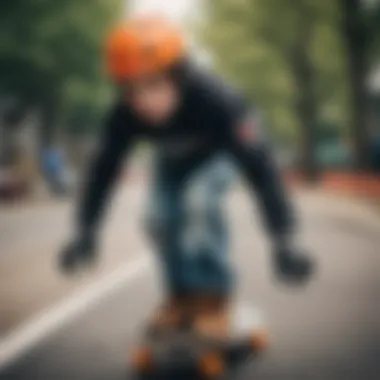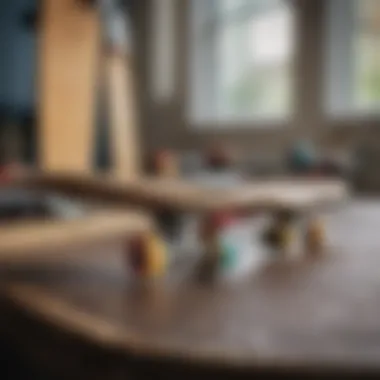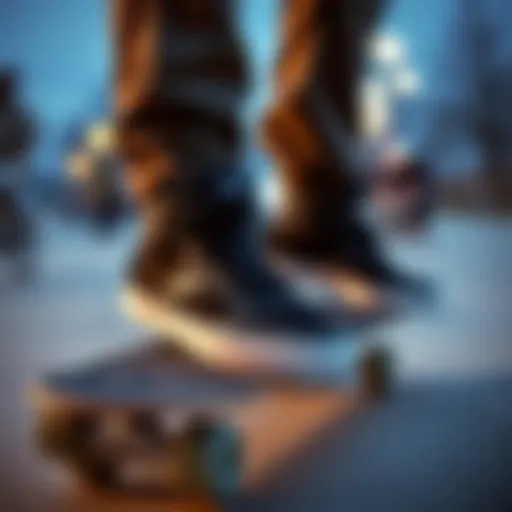Choosing the Ideal Skateboard for Eight Year Olds


Intro
Choosing the right skateboard for an eight year old can be quite a task. Not just any board will do; it’s a selection that combines safety, performance, and design appropriateness for a child’s age and skill level. Parents often wonder how their little ones can zoom down the street while still ensuring they’re secure on their board. Here’s where the fun begins, but it’s essential to approach this without diving straight into the deep end.
At this age, kiddos are often brimming with energy and curiosity, making skateboarding an excellent way to channel that exuberance into an exciting and fulfilling activity. Understanding your child’s individual needs will help in choosing a skateboard that fits them just right. In this article, we will look into various aspects that need consideration—from the type of board to the maintenance and accessories. This guide aims to arm you, the parent or guardian, with all the right know-how to make informed choices.
This exploration goes beyond just picking a skateboard; it’s about fostering a passion that could develop into a lifelong hobby. From basic techniques to skate culture, we'll cover the essentials that make skateboarding a meaningful pursuit. Now, let’s carve our way into the first section!
Skateboarding Techniques
Skateboarding is not just about pushing off the ground and balancing on a board. There’s a world of techniques that makes it a captivating sport for kids, particularly those around eight years old who are just starting out. Focusing on the fundamentals is key to creating a solid base, and it can also keep your child enthusiastic about learning.
Essential Tricks for Beginners
When little ones first hop on a skateboard, simplicity rules the day. Starting with basic tricks can build their confidence and ensure they aren’t overwhelmed. Here are a few foundational tricks that even beginners can try.
- Ollie: This foundational trick helps in leaping from the ground without using your hands. It’s a stepping stone for many other tricks.
- Shuvit: By flicking the tail of the board, your child can make the skateboard spin underneath them, a great trick that looks impressive without requiring a big leap.
- Kickturn: The kickturn is essential for turning on the board; it aids control and navigation, which is crucial for park riding.
Encouraging your child to practice these tricks not only provides a good workout but also gives them a better understanding of balance and control.
Advanced Maneuvers for Seasoned Skaters
As they grow more confident, children may want to try their hand at more advanced maneuvers. These tricks, however, should be approached with caution, ideally in a safe environment, such as a skate park. Some popular advanced techniques include:
- Grind: Arbitrarily sliding along an edge or rail. Mastering this requires good balance and control.
- Manual: This is similar to a wheelie, where the skater lifts the front or back wheels off the ground while rolling.
- 360 Flip: Combining an ollie and a shuvit, this trick makes for a visually stunning display of skill.
Skateboarding can be a rewarding journey. Building on these techniques over time will help keep your child engaged and steadily improving.
"Skateboarding is an extension of the personality of the rider."
By nurturing their enthusiasm, you’ll help pave the way for not just skill development but a sense of belonging in the broader skateboarding community.
Understanding the Needs of Eight Year Olds
Physical Development Considerations
Physical development in eight year olds is celebrated with rapid growth and change, which includes improving coordination and balance. These emerging skills are paramount in activities like skateboarding. Skateboards come in a variety of sizes, and picking one that suits a child’s stature and capabilities is imperative.
- Height and Weight: Choose a skateboard that is designed to support their weight without breaking a sweat. A sturdy deck helps in maintaining balance.
- Width of the Deck: A wider board can provide a more stable platform, especially for beginners. This minimizes the chance of falls, allowing children to build confidence.
- Cockpit Size: Smaller feet will require a skateboard that provides a comfortable foot placement without excessive overhang. A board that accommodates their foot size ensures they have control and feel secure while riding.
A skateboard that fits their physical parameters will empower youngsters to explore and grow as skaters, sky-high potential unlocking each time they step on.
Cognitive and Emotional Readiness
At age eight, kids are not just growing taller, but they are also developing important cognitive and emotional skills. Understanding this transition is key when choosing a skateboard. They are beginning to understand concepts like balance and gravity, which can directly influence their experiences on a board.
- Risk Assessment: Children are learning to evaluate risks and make decisions accordingly. A skateboard that is too advanced can frustrate them or even lead to injury. It’s vital to choose something that feels challenging yet reachable.
- Emotional Support: Learning a new skill can be daunting. Choosing a skateboard that appeals to their preferences—like color or design—can make the experience more pleasurable. Also, have a parent involved during initial practice to provide emotional encouragement.
- Social Dynamics: Kids this age often find joy in social interactions. Joining skating groups or teams can enhance their experience, making a skateboard a tool for connection and camaraderie rather than just a ride.
By ensuring that the skateboard matches their cognitive and emotional readiness, parents can provide a safe and stimulating environment for their child to flourish in a new sport.
Types of Skateboards for Beginners
When it comes to getting a skateboard for eight-year-olds, the choices can be overwhelming. Parents and guardians need to consider the specific types of skateboards available and what works best for their child's needs. Not all skateboards are built equal, and understanding the differences is key to fostering a fun and safe experience for young skaters. Each type has its own set of characteristics that influence how they perform and how suitable they are for beginners.
Standard Skateboards
Standard skateboards, often just referred to as skateboards, typically range from 28 to 32 inches in length. These boards have a narrow width which can make them appealing to the younger crowd as they can easily maneuver. However, this also means that they might not provide the stability that an eight-year-old would prefer when first learning to balance on a board.
One of the benefits of standard skateboards is their versatility. Whether your little one’s keen on practicing tricks or just cruising around the park, standard boards offer a bit of everything. It's wise to check the material of the deck, too; plywood is a common choice for durability and strength. You might find the following points helpful:
- Deck size: A regular-sized board is generally lighter and easier to handle.
- Nose and tail shapes: A slightly lifted nose can help in performing tricks.
- Designs: Kids love colorful graphics, making it more appealing for them to ride.
However, not every child will fit perfectly with this style. If your child seems a bit on the shorter side, it may be worth considering options that cater specifically to smaller riders. Most importantly, a standard skateboard opens a door for skills to be built gradually.
Longboards
Longboards are the gentle giants of the skateboarding world. They can be considerably longer than standard skateboards, often exceeding 32 inches, and their wider and more stable build makes them a fantastic choice for beginners, especially children. The extended deck allows for better balance, which is crucial for new riders still mastering their coordination.
These boards shine brightly for cruising and carving but are not necessarily designed for tricks. Young skaters can enjoy rolling downhill or around the neighborhood without feeling as though they might tumble at any moment. When choosing a longboard, consider the following benefits:


- Stability: The wider deck minimizes the chance of falls.
- Smooth rides: Larger wheels can glide over bumps better, perfect for diverse terrains.
- Comfortable: Kids can enjoy long rides without much discomfort.
Nonetheless, due to their size, longboards can be harder to transport. Make sure they fit in your car or can be carried comfortably, as that can be a hassle sometimes.
Mini Skateboards
Mini skateboards are ideal for younger skaters or those on the smaller side. Typically less than 28 inches in length, these boards allow ease of handling and are lightweight. Their size is perfectly suited for smaller feet, which often belong to eight-year-olds, ensuring they can balance easily while they practice.
While they may not support advanced tricks like the larger boards, they represent a great introductory step to skateboarding. Here's what makes mini skateboards a good pick:
- Lightweight: Easy for kids to carry around.
- Compact size: Fits well in small spaces, making them easy to store.
- Fun colors and designs: These boards often come in vibrant styles that appeal to kids.
A potential downside, however, comes in the form of stability compared to longboards. They're great for practicing tricks once fundamentals are grasped, but might not be stable enough for some children just starting out.
In summary, every type of skateboard comes with its own unique set of benefits and challenges. Knowing what to look for matters, and parents should focus on matching the board with their child's physical needs and skating aspirations. With this in mind, they can help set up young skaters for a successful and enjoyable start on their skateboarding journey.
Key Features to Look for in a Skateboard
When selecting a skateboard for an eight-year-old, understanding the key features is paramount. This choice can greatly influence their enjoyment and safety while skating. Children at this age are undergoing rapid physical and developmental changes, making the right skateboard essential for both performance and learning. Below are crucial aspects that demand attention, ensuring that the skateboard not only meets their needs but enhances their overall experience.
Deck Size and Shape
The deck serves as the fundamental platform of any skateboard, dictating how well it suits a child's size and skill level. For an eight-year-old, ideal deck sizes typically range from 7.5 to 8 inches in width. A wider deck provides stability, which is invaluable for beginners still finding their balance. Conversely, a narrower deck might cater better to kids who are ready to perform tricks and maneuvers.
Shape also plays a critical role. Skateboards can have different profiles:
- Concave decks offer a slight dip in the center, making it easier for young riders to control their foot positioning.
- Flat decks, on the other hand, provide a steady and forgiving surface which can be interesting for beginners experimenting with various movements.
It's worth noting that some brands offer skateboard decks with graphics or colors that resonate with kids, sparking excitement about getting on the board.
Wheel Type and Size
Wheels are essential to how a skateboard rides. The size and material of the wheels profoundly affect the skateboard's performance. For children, wheels typically range from 50 to 54 mm in diameter. Smaller wheels provide better control and are suitable for trick riding. Larger wheels, around 55 mm and above, increase speed and smoothness, ideal for cruising around the neighborhood or skatepark.
Material wise, urethane wheels generally offer a perfect balance between durability and grip. They absorb shocks from surfaces like asphalt or concrete, making rides smoother. Parents should also consider the hardness of the wheels, measured by a durometer scale. Softer wheels (78A to 87A) tend to grip better on rough surfaces, a plus for learning.
Truck Quality
Trucks are the metal parts that connect the wheels to the deck. Their quality is directly tied to the skateboard's overall performance and safety. When looking for trucks for kids' skateboards, a few aspects should be kept in mind:
- Material: Aluminum trucks are lightweight and durable, perfect for children's needs. They offer a great mix of strength and agility while keeping the board manageable when learning.
- Axle Width: Make sure the trucks align with the width of the deck. Mismatches can result in instability.
- Height: Low, medium, and high are the three types available. Lower trucks make it easier to land tricks, while higher ones provide more clearance for wheels when going over terrain.
Ultimately, investing in quality trucks can elevate the ride experience and enhance safety, ensuring the young skater enjoys their time on the board without undue worry.
"Choosing the right skateboard isn’t just about style; it’s about finding the perfect balance between safety, functionality, and fun."
These features collectively pave the way for a positive introduction to skateboarding for kids. When equipped with the right components, they can build skills, confidence, and enjoy the ride, which is what it's all about.
Safety Considerations
When it comes to skateboarding, especially for kids around the age of eight, safety can't be an afterthought. Choosing the right skateboard is important, but ensuring that the child is safe while using it is paramount. In this section, we’ll dive into various aspects of safety considerations that every parent or guardian should prioritize. Fostering a safe environment and properly equipping a young skater with safety gear not only helps to minimize risks but also builds confidence and encourages them to enjoy skateboarding fully.
Importance of Safety Gear
Helmets
Helmets are your child’s first line of defense against head injuries while skating. The main function of a helmet is to absorb impact and protect the skull in case of a fall. A well-fitted helmet is crucial. Look for models designed specifically for skateboarding, as they typically have a thicker foam padding, which helps in shock absorption. It's often recommended to choose a helmet that meets the safety standards of organizations like the CPSC (Consumer Product Safety Commission).
One key characteristic of helmets is their comfort. Discomfort can lead a child to remove the helmet, rendering it useless. Many helmets nowadays come with adjustable straps and pads for a snug fit.
However, not all helmets are created equal. Some may be bulkier or weigh more than others, which could deter a young skater from wearing it properly. So, finding a balance between protection and comfort is vital.
Knee Pads
Knee pads play a significant role in protecting a child’s knees during falls— a common occurrence, especially for beginners. They are designed to absorb the impact, thereby preventing scrapes, bruises, or even more serious injuries. Knee pads should fit snugly but not be too tight, allowing for ease of movement while skating.
A key characteristic of knee pads is their coverage. Look for models that extend above and below the kneecap for maximum protection. Some knee pads also have hard plastic shells that enhance durability and protection.
However, it's essential to watch for the downside; some knee pads can be bulky and might restrict leg movement, which could hamper a child’s ability to skate freely. Picking a lighter, more flexible option will help in maintaining comfort.
Elbow Pads


Similar to knee pads, elbow pads are meant to protect the elbows from impact during falls or tumbles. Skaters often overlook elbow protection, but injuries to this area can be quite painful. Proper elbow pads provide cushioning and help absorb falls more effectively.
One of the standout features of quality elbow pads is their ergonomic design. This allows them to fit comfortably without excessive bulk, which means they won’t hinder movement. Look for elbow pads with breathable materials to keep the child cool.
In terms of disadvantages, if the elbow pads are not fitted correctly, they may slip down during use, exposing the elbow to potential scrapes. Therefore, trying them on is essential before making a purchase.
Supervision and Safe Environments
Supervision is essential for any eight-year-old engaging in skateboarding, especially when they are just starting. It's natural for young kids to feel adventurous, and without proper guidance, they may attempt tricks or stunts that could lead to serious injuries.
Parents and guardians should aim to create a safe environment for young skaters. This could mean finding areas free of obstacles, traffic, and uneven surfaces. Skate parks are often ideal because they offer a designated space for skaters to learn and practice without the interference of vehicles or pedestrians.
Here are some factors to keep in mind:
- Clear Spaces: Ensure that the area where the child is skateboarding is clear of debris, rocks, or other obstacles.
- Suitable Terrain: Flat, smooth surfaces are best for beginners. Avoid hilly or uneven ground until the child gains more confidence and skill.
- Peer Interaction: Monitor their interactions with others while skating. Encouragement among peers can go a long way in building confidence.
By encouraging safe practices and keeping a watchful eye, you’re not just protecting your child—you’re creating an atmosphere where they can learn and thrive in their new hobby.
Popular Skateboard Brands for Kids
When it comes to skateboarding, choosing the right brand can make a world of difference for young riders. Kids not only want to look cool while cruising down the street, but they also need a board that complements their developing skills. A reputable brand is essential because it often reflects quality, sturdiness, and reliability. Parents need to consider how well a brand stands up to wear and tear, especially for children who are just finding their footing.
Trusted brands have established themselves in the market by offering durable and safe products. Generally, a skateboard from a well-known manufacturer can act as a safety net, ensuring that what your child rides is built to last and isn’t just a flimsy replica. This reassurance is vital for parents who want their children to enjoy a thrilling, yet safe, skateboarding experience.
"Choosing a skateboard is not only about the style; it's about finding a balance between fun and safety."
Overview of Trusted Brands
When delving into trusted skateboard brands for kids, it's crucial to focus on those renowned for their reliability and commitment to quality. Here are some names that often stay at the top of parents' lists:
- Element: This brand has built a solid reputation around skate culture, offering solid products that cater to various skill levels.
- Skate One: Known for its high-quality construction, Skate One often tops the chart for kids' boards.
- Coast 2 Coast: A favorite among parents for its affordability paired with durability.
- Rimable: This brand is popular for colorful designs and beginner-friendly boards.
- Powell Peralta: A historic brand that blends classic designs with modern innovation.
These brands have proven track records and offer a selection of boards that can cater to different needs, ensuring a good fit for your child's specific skating style and requirements.
Brand Comparisons
As you embark on the journey to find the perfect skateboard, it's beneficial to compare different brands and their offerings. Each brand typically has its strengths and weaknesses that can influence your decision.
Here's a simple breakdown of how these brands stack up against each other:
- Element vs. Skate One: Element is known for more customizable options while Skate One excels in stability and resilience. If your child is more into tricks, Element may have an edge.
- Coast 2 Coast vs. Rimable: Coast 2 Coast boards often feature more sturdy designs suitable for learning. Rimable distinguishes itself with eye-catching graphics, which can attract kids, making it an appealing choice for younger riders.
- Powell Peralta stands in a league of its own due to its historical significance and quality construction. It's generally pricier but revered by those serious about skating.
By weighing the pros and cons of these trusted brands, parents can make a well-informed choice that caters not only to functionality but also aligns with their child's enthusiasm for skateboarding.
How to Teach Eight Year Olds to Skateboard
Teaching eight-year-olds to skateboard isn’t just about showing them how to stand on the board and roll forward. It’s a delicate blend of fostering skills, building confidence, and instilling enthusiasm for the sport. At this age, children's bodies are growing and developing rapidly, especially in coordination and balance. An easy-going, gradual approach can make this learning experience enjoyable and rewarding.
Moreover, understanding individual readiness is crucial. Some kids might take to it like a duck to water, while others may need a bit more time to find their footing. It's vital to adapt techniques to suit each child, creating a personalized experience in learning.
Basic Techniques and Progression
Mastering skateboarding basics sets the stage for future skills. Here are some key techniques to introduce to youngsters:
- Balancing: Have them practice standing still on the board, using sturdy surfaces to help with stability. Encourage them to shift their weight from one foot to another, which is foundational for riding.
- Pushing Off: Once balance is established, the next step is pushing off. Show them how to use one foot to propel the board. Having them pick a flat area free from distractions is ideal for this exercise.
- Turning: Create a simple obstacle course with cones. This helps them learn to steer while gaining confidence and control.
- Stopping: Teaching a safe stop is equally essential. A simple method is dragging one foot on the ground or using the tail of the board to break will help them learn to stop properly.
Encourage them to practice each step repeatedly, without pushing too hard or rushing them. Making small, incremental progress builds confidence rather than pressure.
Encouraging Safe Practices
Safety must remain paramount throughout the teaching process. Firstly, ensure that they wear the right protective gear like helmets, knee pads, and elbow pads. Gear isn’t just a suggestion; it’s a necessity. It builds habits that keep them safe, helping avoid unfortunate spills that lead to injuries.
It's also beneficial to model safety practices. Use clear instructions on how to fall correctly to minimize injury if they stumble. Demonstrating controlled falls can show kids how to handle unexpected slips.
Additionally, supervise practice sessions closely. Ensure they skate in safe environments, like a flat surface away from roads, where they can focus on their skills rather than worrying about obstacles or traffic.
Being patient and providing positive reinforcement can boost their motivation immensely. Celebrate small victories to nurture their passion for skateboarding. Choosing fun challenges rather than overwhelming tasks can keep lessons aligned with their capabilities and interests.
Remember, the goal here is to have fun and learn, not rush into things. Progress is measured in joy and excitement rather than speed or perfection.


Maintenance of Skateboards
When it comes to skateboards, maintenance might seem like a mundane topic but it's far from it. Keeping a skateboard in tip-top shape can not only extend its life but also ensure safety for those little skaters zooming around. Regular attention to a skateboard means fewer chances of mishaps, keeping kids happy while they ride. Parents should not overlook this aspect as it lays the groundwork for a solid skateboarding experience.
Each part of a skateboard, from the deck to the wheels, has its own wear and tear. Regular maintenance not only helps parents spot potential issues before they escalate but also teaches children responsibility and care for their equipment.
Regular Inspection
Regular inspection of a skateboard is paramount. Like any other sporting equipment, skateboards experience wear over time. This wear may not be immediately visible, which makes consistent checks essential. Parents should make it a habit to inspect the skateboard every couple of weeks, especially if it's used frequently.
Key areas to examine include:
- Deck: Look for cracks or significant scratches which can weaken the board. A damaged deck may not only affect performance but also pose a danger while riding.
- Wheels: Check for flat spots or wear that can disrupt smooth rolling. If the wheels are uneven, it might be time to replace them to keep that quick burst of speed.
- Trucks: Ensure that the trucks are secure and not loose. Loose trucks can lead to wobbly rides, which can be unsettling for young skaters.
Noticing small issues early can save a lot of trouble later on. Having a reliable method of inspection not only ensures the skateboard lasts longer but also keeps the skater safe.
Repairing Common Issues
Despite best efforts, skateboards will encounter problems every now and then. Knowing how to quickly address common issues can make the difference between riding safely or facing unnecessary accidents.
Here are some tips for addressing frequent skateboard issues:
- Worn Wheels: If wheels appear worn or develop flat spots, sometimes it's just a matter of replacing them. Most skateboard shops sell replacement wheels, which can be a straightforward fix. Look for wheels that match the current size for optimal performance.
- Loose Trucks: If wheels wobble or the skateboard feels unstable, check the bolts on the trucks. They can loosen over time and simply tightening them can often resolve the problem.
- Deck Damage: For small cracks or chips in the deck, some may opt to sand down the area or use a waterproof epoxy to seal it. Remember, however, if the damage is severe, replacing the deck may be prudent. Safety should always come first.
"Regular maintenance of a skateboard not only prolongs its lifespan but most importantly safeguards the rider. Spotting tiny issues before they become big problems is key."
Community and Resources for Young Skaters
Creating a sense of community around skateboarding can enhance the experience for young skaters and their families. For eight year olds, learning in a supportive environment is crucial. Local skateboarding clubs or online forums play a significant role in this process. These options provide not just a space for physical activity but also a hub for education, safety, and social interaction.
Engagement with a community opens up various avenues for young skaters. Parents can connect with other guardians, swap tips, and discuss different styles and types of skateboards. These interactions can foster friendships among the kids, giving them a chance to learn from one another. Consistent involvement in a community can boost a child’s confidence, as they watch their peers progress in skill.
Moreover, many clubs organize events or competitions. These gatherings can be motivating for young skaters. They give children something to aim for, encouraging them to set goals and strive to improve. Since skateboarding can sometimes be a solitary activity, community support makes the experience more fun and inclusive.
Local Skateboarding Clubs
Local skateboarding clubs offer a focused place for young skaters to learn and develop their skills. Generally, these clubs host regular practices and workshops. Participation in such clubs can significantly accelerate a child’s learning process.
Clubs also provide opportunities for supervised skate sessions which can be remarkably beneficial. Supervision from experienced skaters assures that kids practice safely while mastering techniques correctly.
Here are a few benefits of joining a local skateboarding club:
- Skill Development: Access to coaching helps in learning essential skills faster.
- Safe Environment: Well-organized sessions ensure safety standards are met.
- Social Connections: Kids get to meet peers with similar interests, creating friendships and camaraderie.
- Events and Competitions: Regular events keep the spirit lively and encourage friendly competition.
By participating in local clubs, kids receive guidance that can greatly improve their techniques while enjoying the camaraderie of fellow skaters.
Online Communities and Forums
In today’s digital age, online communities and forums provide an alternative venue for young skaters and their parents to connect. Platforms like Reddit or specific Facebook groups can be treasure troves of information. They allow discussions around tips, tricks, and strategies tailored to younger skaters.
Engaging in these communities offers several unique advantages:
- Accessible Information: Parents can get insights about the best skateboards, safety gear, and experiences from other skate families.
- Shared Resources: Online platforms often share guides, tutorial videos, and recommendations for local instructors or clubs.
- Support Networks: Such communities create virtual support systems. Parents can ask questions and share concerns, allowing collective problem-solving.
- Awareness of Events: Online forums often share details about local contests, clinics, or meet-ups that would otherwise be easy to miss.
While local clubs are vital for physical practice, online communities ensure that family members engage with a broader spectrum of resources and ideas. Both avenues together enrich the overall experience for young skaters and their families.
Culmination
As children embark on this exciting journey of skateboarding, safety gear becomes paramount. From helmets to knee pads, ensuring that the young skater is properly equipped can significantly reduce the risk of injury. Supervision in safe environments only strengthens this foundation of safety, allowing kids to explore while feeling secure.
Beyond safety and product knowledge, understanding the emotional readiness of an eight year old plays a crucial role. Children develop at different paces, making it critical for parents to assess their child’s comfort and eagerness to learn a new skill. This assessment not only fosters a positive environment for skateboarding but also instills confidence in the young skater, encouraging them to take on challenges at their own pace.
The process of selecting a skateboard should ultimately be a collaborative effort, engaging both the parent and child in meaningful discussions about their preferences and experiences. This collaboration can lead to a well-informed purchase and an enjoyable skateboarding experience that nurtures their budding interest.
Recap of Key Points
- Understanding Physical Development: Assessing a child's physical size and strength is vital for skateboard selection.
- Types of Skateboards: Choose between standard skateboards, longboards, or mini skateboards based on the child’s interests.
- Key Features: Deck size and shape, wheel type, and truck quality can impact performance and safety.
- Safety Gear Importance: Helmets, knee pads, and elbow pads are essential to keep young skaters safe.
- Community Resources: Tapping into local skateboarding clubs and online communities can provide support and camaraderie.
Encouragement for Parents and Guardians
It’s essential to rally behind your children when they show interest in skateboarding. Your support can mean the world, transforming their skateboarding experience from a simple leisure activity into a powerful learning opportunity. Encourage them to explore in a structured way, instilling patience and resilience along their journey.
Don’t hesitate to tap into local skateboard clubs or online forums to connect with others. Engaging with the community not only offers resources for learning but also fosters lifelong friendships through shared passions. When they see your involvement and encouragement, it strengthens their confidence and willingness to skate more.
Investing in the right equipment and providing an encouraging environment can significantly enhance their overall experience. So gear up, hit the parks, and share in the joy of learning a dynamic sport together.















